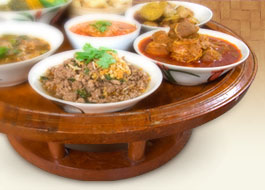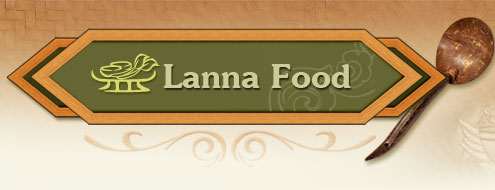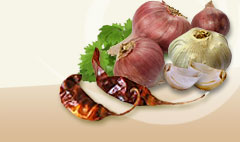Bean sprouts |
|
|
 | Vigna radiate Welczek |
|
| |
 | Leguminaosae |
|
| |
 | Golden gram, Greem gram, Mung bean sprouts, Bean sprout |
|
| |
 | Thau ngok, Thua phao, Ngo pathim (Songphan Wannaas, 1999, p. 2634) |
|
| |
 | In northern Thailand, bean sprouts are usually made from mung beans by soaking them for 3-4 hours and then germinating them in an old tin can (gasoline can) with the lid and bottom taken out and filled with layers of sand or ashes from burning rice husks (the latter tends to produce an unpleasant dirty looking sprouts). The first layer of sand should be 5 cm. high and thinly sprinkled with soaked mung beans on it. Then add another layer of sand 1 cm. thick and sprinkle the soaked beans on it. Continue alternating layers of sand and mung beans and leave about a 5-cm. space at the top. Wet thoroughly and cover with an old sack or paper or other kind of wet material. Keep watering once in the morning for 2-3 days in the summer or 6-7 days in the winter. Then sift out the sprouts and wash many times until very clean. Bean sprouts can be eaten fresh or cooked to make quite a variety of dishes. (Sangphan Wannamas, 1999, p. 2634) |
|
| |
 |

A good source of digestive proteins high in Vitamin C and B12 (Thawithong Hongwiwat, 2004, p. 121) |

This kind of bean is known to prevent cancer, especially in the intestines and anal cancer, to treat cardiac disease and infections. |
|
| |
 | All year round |
|
| |
 |
Sangphan Wanamas. Thua Ngok. In Saranukrom Wattanatham Thai Phak Nuea. (Vol.5, p. 2635). Bangkok: The Siam Commercial Bank Foundation for the Encyclopedia of Thai Culture. (in Thai). Thawitong Hongwiwat. (2004). Saranukrom Phak. 2nd ed. Bangkok:Saengdaet.. (in Thai). |
|
| |
|
|




